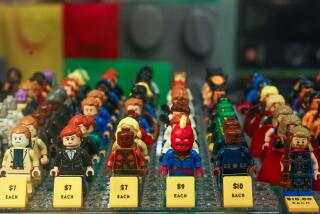A Toy Story With a New Beginning
- Share via
NEW YORK — Last Christmas, FAO Schwarz looked more like a picked-over flea market than the fabled toy emporium that had weaned generations of Manhattanites.
Shelves were half empty. Garish yellow “sale” signs hung everywhere. And in a prelude to the store’s expected demise, shoppers were warned that all sales were final.
But after a 10-month closure, the world’s most famous toy store is once again making sales.
Under new ownership and a revamped business plan, FAO’s flagship store reopened here Thanksgiving Day.
(The only other branch, in Las Vegas, reopened in October at the Forum Shops at Caesars Palace. Thirteen other stores have been shuttered permanently. A few years ago, FAO had four stores in Southern California.)
But back are the icons familiar to generations of New Yorkers: the life-sized stuffed animals and the toy soldier-doormen who stand sentry outside FAO’s Fifth Avenue entrance.
On the top floor, children line up to toe-tap a replica of the floor-length piano keyboard that Tom Hanks made famous in “Big.”
But much has changed, starting with an elaborate refurbishment of FAO’s three floors.
Aisles have been enlarged to be stroller friendly. Displays that had lined the store’s blocklong windows have been removed to make way for expansive views of the Plaza Hotel. A kaleidoscopic 20,000-light ceiling grid greets shoppers in the main entryway.
The physical changes underscore a dramatic shift in FAO’s business strategy.
FAO, which dates to 1862, is no longer trying to match the likes of Toys R Us and Wal-Mart, the cut-rate competitors that nearly drove it out of business. Toys commonly found elsewhere have been dropped. The store, for example, doesn’t carry a single video game.
Instead, FAO is pursuing a dual-pronged strategy of highlighting exclusive toys as well as items with price tags that won’t scare away the masses.
FAO has a $50,000 child-sized Ferrari and a $300,000 3D Motion Simulator, an eight-seat mini-theater that moves and shakes. (Warning: complimentary gift wrapping is not available for the motion simulator.)
But, FAO stresses, its average price tag is $20.
A collector’s edition Slinky Dog is $18 and a poker set goes for $38.
“We have a little bit of everything for everybody,” said Kim Richmond, FAO’s executive vice president of marketing.
The strategy seems promising, but is untested.
Although the store is sure to lure crowds, it runs the risk that shoppers will spend an hour gawking before leaving empty-handed.
Not selling video games, for example, could turn off adolescent boys, a key demographic.
“We certainly wrestled with the issue of video games because they’re so popular,” Richmond said. “But we knew we couldn’t add value if we just stocked video games along a wall.”
To help capture youths -- not to mention their nostalgic parents -- the ground floor, dubbed the Rec Room, resembles a home family room. Outfitted with a large-screen TV and surrounding couches, shoppers can play air hockey, pinball and foosball.
Patrons at the store one recent day seemed to like the changes.
“It’s better than it was before,” said Amanda Carter, a Yorkshire, England, resident who came to FAO on the first day of a vacation with her husband and son. “We were very upset that it [had] closed.”
Cindy Moran of Stony Point, N.Y., came to look for Christmas gifts for her family.
“I was looking at that until I saw the price,” she said, pointing to a combination exercise machine-computer game selling for $1,200. “I think we’ll be buying something before we leave. Not this, but something for Christmas.”
Shoppers like Moran will determine FAO’s fate.
The company has disclosed neither the cost of the remodeling nor its current sales figures.
But given the obvious time and effort put in, this may be FAO’s last chance at success.
“We don’t ever look at it that way,” Richmond said. “We took it on as a challenge, and we said we wanted to come back in a spectacular manner.”
More to Read
Inside the business of entertainment
The Wide Shot brings you news, analysis and insights on everything from streaming wars to production — and what it all means for the future.
You may occasionally receive promotional content from the Los Angeles Times.










